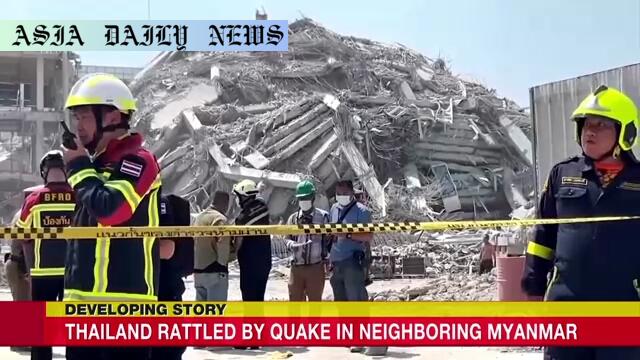Earthquake – Two powerful earthquakes in Myanmar caused destruction, fatalities, and panic, affecting regions across Southeast Asia.

Myanmar Struck by a Powerful 7.7 Earthquake
A catastrophic earthquake with a magnitude of 7.7 hit Myanmar on Friday afternoon, causing widespread devastation and fatalities. The epicenter was located near Mandalay, Myanmar’s second-largest city, at a depth of about 10 kilometers, according to the US Geological Survey. The initial quake was followed just 10 minutes later by a powerful aftershock measuring 6.4 in magnitude. Both tremors caused immense destruction to infrastructure, leaving communities near the epicenter devastated.
Myanmar, which has experienced seismic activity in the past, faced significant consequences from the intensely shallow earthquake. Damages extended beyond Mandalay, affecting the nation’s capital, Naypyitaw, 250 kilometers away. Reports indicate that residential buildings, bridges, and older structures sustained severe damage, leading to chaotic evacuations. Myanmar’s state authorities quickly declared a state of emergency in some areas as images showcasing collapsed structures and frantic rescue scenes emerged from the affected locations.
Impact on Neighboring Countries
The earthquake’s ripple effects were felt far beyond Myanmar’s borders. Bangkok, the capital city of Thailand, located approximately 1,000 kilometers from the epicenter, experienced perceptible shaking. Buildings swayed for over a minute in the city, triggering panic and chaos among residents. A skyscraper under construction collapsed, resulting in at least two deaths and 12 injuries. Rescue operations remain ongoing, with around 70 individuals reportedly trapped under the rubble. Additional incidents were reported across Bangkok, including the collapse of a crane at another construction site, which tragically claimed another life.
A Region in Shock and Recovery
The seismic event has left communities across Southeast Asia in shock. In statements to local media, witnesses described the terror of the moment when the ground started to shake. One individual recounted seeing safety alarms at a mall going off, people running in panic, and buildings visibly swaying. The panic and destruction underscore not only the sheer power of the earthquake but also the vulnerability of many regional structures to seismic events.
In response to the disaster, Myanmar’s military junta sent its leader, Min Aung Hlaing, to visit injured citizens and oversee rescue efforts. This move comes amidst the ongoing political turmoil in Myanmar, where the government has faced criticism since its military coup in 2021. However, authorities emphasized their focus on providing aid to affected communities, setting aside political tensions for the time being.
Seismic Activity in Myanmar’s History
Myanmar has a long history of seismic activity due to its location near major fault lines. Over the past 15 years, the country has suffered three significant earthquakes, including one in 2011 that resulted in over 70 fatalities. Experts in seismology emphasize the need for improved infrastructure resilience in the region to minimize future casualties and damages. Modernization efforts, particularly for older buildings, remain a critical objective for authorities as they contend with the apparent threat posed by recurring seismic events.
The dual earthquakes on Friday serve as a tragic reminder of the natural vulnerabilities faced by countries in Southeast Asia. As rescue efforts continue, regional governments will likely re-evaluate their readiness for large-scale natural disasters and focus on enhancing preventive measures.
Commentary
The Scale and Impact of Natural Disasters
Natural disasters like the 7.7 magnitude earthquake in Myanmar remind us of the unpredictable and devastating forces of nature. Such events test the resilience of communities, infrastructures, and governments. Beyond the destruction and casualties, they highlight how unprepared certain regions may be for large-scale disasters. Southeast Asia, with its susceptibility to earthquakes, faces the dual challenge of mitigating immediate disasters while working on long-term preparation and recovery strategies. Modernizing infrastructure must become a priority for countries in this region to prevent further loss of lives and property in similar future incidents.
Myanmar’s Fragile State in Crisis
The earthquake also shines a spotlight on Myanmar’s current vulnerability, exacerbated by political unrest and an economy strained under military rule. While the immediate disaster has united many in rescue and recovery efforts, the country’s rebuilding phase could face additional challenges due to strained resources and geopolitical dynamics. The involvement of Min Aung Hlaing and the military junta in relief operations presents an opportunity to gain public trust, but the wider socio-political dynamics cannot be ignored. As Myanmar rebuilds, international support could play an instrumental role in easing its recovery process.
Lessons for Regional Preparedness
The quake’s far-reaching effects in neighboring Thailand also illustrate the interconnectedness of Southeast Asian countries when it comes to natural disasters. The collapse of a skyscraper in Bangkok raises questions about building standards and enforcement of safety regulations. As urbanization continues in the region, governments must ensure that development does not outpace disaster preparedness. Collaborative efforts, such as shared seismic research and regional disaster response initiatives, could help better prepare countries for future events. While the immediate priority is to save lives and address the crisis at hand, lessons learned from this earthquake could pave the way for safer, more resilient communities across the region.


